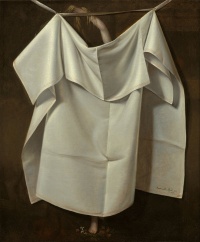Handkerchief
From The Art and Popular Culture Encyclopedia
|
"The case of music is almost like that of the delight derived from a smell that diffuses itself widely. The man who pulls his perfumed handkerchief out of his pocket attracts the attention of all round him, even against their will, and he forces them, if they are to breathe at all, to enjoy the scent ; hence this habit has gone out of fashion." --Critique of Judgment (1790) by Immanuel Kant |
|
Related e |
|
Featured: |
A handkerchief , also called a handkercher or hanky, is a form of a kerchief, typically a hemmed square of thin fabric that can be carried in the pocket or purse, and which is intended for personal hygiene purposes such as wiping one's hands or face, or blowing one's nose. A handkerchief is also sometimes used as a purely decorative accessory in a suit pocket.
The material of a handkerchief can be symbolic of the social-economic class of the user, not only because some materials are more expensive, but because some materials are more absorbent and practical for those who use a handkerchief for more than style. Handkerchiefs can be made of cotton, cotton-synthetic blend, synthetic fabric, silk, or linen.
Handkerchiefs were also used, especially by children, as an impromptu way to carry around small items when a bag or basket was unavailable. They could also serve as a substitute for a bandage over a small injury. In the United Kingdom, the habit of wearing a handkerchief with tied corners on one's head at the beach has become a seaside postcard stereotype, referenced by the Gumby characters in Monty Python's Flying Circus.
King Richard II of England, who reigned from 1377 to 1399, is widely believed to have invented the cloth handkerchief, as surviving documents written by his courtiers describe his use of square pieces of cloth to wipe his nose. Certainly they were in existence by Shakespeare's time, and a handkerchief is an important plot device in his play Othello.
Modern usage
The use of a cloth handkerchief is occasionally considered old-fashioned or unhygienic, or both, in some parts of the world, mainly due to the popularization of disposable paper handkerchiefs and the fact that they are stored in a pocket or a purse after being used. However, they are a potentially more environment-conscious choice, as cloth handkerchiefs are reusable.
Signals may also be sent by handkerchief, such as the American LGBT handkerchief codes. In Spanish football or in bullfighting, it is a common sight to see supporters waving white handkerchiefs as an expression of deep emotion. It is used both positively, in admiration of an exceptional performance by a team or player, or as a negative sign of disgust at an especially bad performance.
Folding styles
When used as an accessory to a suit, a handkerchief is known as a pocket square. There are a wide variety of ways to fold a pocket square, ranging from the austere to the flamboyant:
- The Presidential, perhaps the simplest, is folded at right angles to fit in the pocket.
- The TV Fold looks similar but is folded diagonally with the point inside the pocket.
- The One-point Fold is folded diagonally with the point showing.
- The Two-point Fold is folded off-center so the two points do not completely overlap.
- The Three-point Fold is first folded into a triangle, then the corners are folded up and across to make three points.
- The Four-point Fold is an off-center version of the Three-point Fold.
- The Cagney is basically a backwards version of the Four-point Fold.
- The Puff or the Cooper is simply shaped into a round puff.
- The Reverse Puff is like the Puff, except with the puff inside and the points out, like petals.
- The Astaire is a puff with a point on either side.
- The Straight Shell is pleated and then folded over to give the appearance of nested shells.
- The Diagonal Shell is pleated diagonally and then folded.
See also


